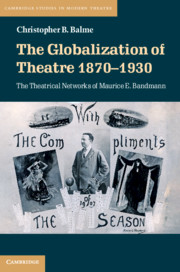Book contents
- The Globalization of Theatre 1870–1930
- Cambridge Studies in Modern Theatre
- The Globalization of Theatre 1870–1930
- Copyright page
- Contents
- Figures
- Tables
- Acknowledgements
- Notes on Currency
- Introduction
- 1 Family Networks
- 2 Mobile Enterprises
- 3 The Micropolitics of Locality
- 4 Repertoire and Publics
- 5 Transported Actors
- 6 Contested Contracts
- 7 Infrastructure: From Theatre to Cinema
- 8 Legacies
- Bibliography
- Index
2 - Mobile Enterprises
Published online by Cambridge University Press: 12 October 2019
- The Globalization of Theatre 1870–1930
- Cambridge Studies in Modern Theatre
- The Globalization of Theatre 1870–1930
- Copyright page
- Contents
- Figures
- Tables
- Acknowledgements
- Notes on Currency
- Introduction
- 1 Family Networks
- 2 Mobile Enterprises
- 3 The Micropolitics of Locality
- 4 Repertoire and Publics
- 5 Transported Actors
- 6 Contested Contracts
- 7 Infrastructure: From Theatre to Cinema
- 8 Legacies
- Bibliography
- Index
Summary
discusses how Bandmann organized and managed his enterprises, which grew in scale from traditional actor management to small joint-stock companies, followed by various partnerships until he finally established limited companies traded on the Indian stock market. He also formed partnerships with the burgeoning variety business. The chapter also discusses the decline of his theatrical business model after World War I due to increased costs and the emergence of cinema. The final section provides an analysis of the economics of touring.
Keywords
- Type
- Chapter
- Information
- The Globalization of Theatre 1870–1930The Theatrical Networks of Maurice E. Bandmann, pp. 57 - 92Publisher: Cambridge University PressPrint publication year: 2019

